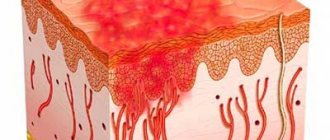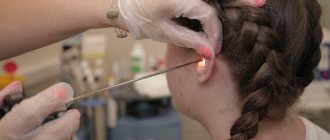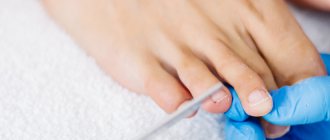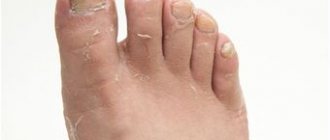Of the half a million species of fungi that exist on earth, in water, and in the atmosphere, almost five hundred species are capable of causing serious diseases in humans and animals. Without a microscope, however, you can’t see fungi. They creep into the body gradually and can slowly devour us.
There are more and more people suffering from fungal diseases every year. Every sixth person on the planet suffers from a fungal disease. But not everyone runs to a mycologist. Why? It doesn't hurt, after all. Here is the answer.
It is pain that pushes us into the arms of a dentist, surgeon, or otolaryngologist. The insidiousness of fungal diseases lies in the fact that there is no pain. So - spots, redness, itching. Maybe there's no need to panic?
Causes of fungus
Not everyone gets sick with deep mycoses. The body of healthy people successfully resists these infections. People with reduced immunity and those suffering from chronic diseases are most susceptible to deep mycoses, for example, bronchial asthma, chronic bronchitis, diabetes mellitus, and inflammatory diseases of the genital organs. Sometimes people who have undergone major operations become infected, because their body’s resistance is sharply reduced. Mycoses can also develop during long-term use of antibiotics.
Who mainly develops fungi?
As a rule, babies do not have them, because they do not have nail infections (since nails grow very quickly and nothing stagnates) and the digestive and immune systems are completely different, since nothing stagnates for them yet and they eat what they eat. what will we give them?
It’s good that mothers are all very smart now and look at the ingredients before giving food to their child. If you want to give your child something to chew on, please read the package to make sure there is no dry yeast. They will already begin to activate in the body at 37 degrees. And for yourself, also choose products that do not contain yeast and sugar - because this is an explosive mixture that harms the entire body. You need to eat such foods so that the mushrooms have nothing to eat.
Fungi in adults become more active after the age of 30, when we experience stagnation, when we sit a lot, when we are full of carbohydrates and do not want to eat right. Just imagine if you ate pasta in the morning, then potatoes, then condensed milk: you feed the entire colony of mushrooms all day long.
Hence the feeling of hunger, because they eat it and you don’t eat it. Your body needs fiber, amino acids, you need protein, fructose and everything natural.
And now is the time when it is very important that you buy exactly those products that actually have bactericidal properties.
Because now, during this period, we started talking about mushrooms, continuing the topic of immunity. Especially during epidemics, it is important to help your immunity.
Types of mycoses
The most common fungus
The most common mycosis is candidiasis , which is caused by yeast-like fungi of the genus Candida. Most often, candidiasis of the mucous membranes of the oral cavity and female genital organs occurs, which is called thrush. In addition, candida can affect the upper respiratory tract, lungs, intestines and other organs.
Candidiasis of the esophagus. Photo: Pediatric gastroenterology, hepatology & nutrition / Open-i (CC BY-NC 4.0)
The most dangerous and highly contagious deep mycoses include coccidioidosis and histoplasmosis.
Coccidioidosis
Coccidioidosis is most common in the United States (about 100 thousand people become ill every year) and in Latin American countries. Coccidioides infection occurs by inhaling dust containing fungal spores or through broken skin. The disease occurs with severe damage to the skin (abscesses and ulcers form) and internal organs (especially the lungs) and can be fatal.
Pulmonary fibrosis caused by coccidioidomycosis. Photo: PHIL CDC
Histoplasmosis
Histoplasmosis is most common in both the Americas and North Africa. Infection occurs by inhalation of fungal spores in soil and dust. The respiratory tract, bone marrow, liver, spleen, and lymph nodes are most often affected. In half of the cases, the process involves the skin and mucous membranes with the formation of ulcers and papillomatous growths. In people with normal immunity, the disease is benign and manifests itself with weakness, fever, and cough. A severe course of the disease with possible death is typical only for patients with AIDS.
Histoplasmosis of the larynx. Photo: Colombia médica (Cali, Colombia) / Open-i (CC BY 3.0)
Aspergillosis
One of the most common deep mycoses is aspergillosis . It is caused by mold fungi of the genus Aspergillus, which form white or greenish mold on rotten trees, shavings, vegetables, fruits, bread, homemade products, dried fruits, and indoor plants. They are also common in residential areas with leaking pipes, damp walls and ceilings, and in ventilation systems and air conditioners. If a person takes a deep breath while in such a room, the spores of these fungi, scattered in the air, enter the bronchi and lungs. As a result, people suffering from serious illnesses or having reduced immunity may experience poisoning and develop aspergillus mycotoxicosis.
Ureteral aspergilloma. Photo: Yonsei medical journal / Open-i (CC BY-NC 3.0)
Possible complications
Mycotoxicoses are associated with poisoning by fungal waste products—mycotoxins. People become ill with mycotoxicoses as a result of eating grain products sprouted by molds, dairy or other products containing mycotoxins, as well as inhaling dust with large amounts of fungal spores. Damage to the respiratory tract is accompanied by a painful cough, hemoptysis, nausea, vomiting, headaches, and fever.
There are also other mold mycoses - mucorosis, penicillium, fusariotoxicosis, etc.
The best ways and methods of getting rid of fungi from the body.
Today we’ll talk about something important: how to get rid of mushrooms in the body.
To do this, I would like to examine this topic: what are mushrooms? So you understand how serious this really is. Up to 50 species of fungi live in our body: mushrooms and mold are all of the same breed and, it must be said, they live not just on their own, but in colonies.
All colonies are interconnected in the body, so they form a whole network inside our body, which disrupts the functioning of all systems and organs.
Can we resist mushrooms? What is important to do?
How to protect yourself from mold infection?
- Care must be taken when dismantling old, dilapidated dachas and when using stale building material. Fungi that have settled on a tree are especially dangerous.
- Although fungi on food products are less aggressive, nevertheless, a small spot of mold on bread must be carefully cut out, and if mold has appeared in several places, it is better not to eat the bread.
- Rotting places on an apple can be removed, but moldy juicy fruits and vegetables - tomatoes, pears, peaches, apricots, especially if mold has appeared around the seed - will have to be thrown away.
- Without hesitation, pour out compotes, juices and syrups with mold stains, but in confitures and jams with a high sugar content, it is enough to remove the top thick layer.
- You should not eat moldy nut kernels with a bitter, musty aftertaste. You should avoid cottage cheese and other moldy dairy products.
- Small spots of mold on the cheese can be removed, but if the mold has formed inside the head, it's not worth the risk. True, there are cheeses, for example, Roquefort, to which mold gives a special piquant flavor, but if you have a fungal infection, you will have to give up such a favorite delicacy for many gourmets for a while.
How else do mushrooms get into our body?
And they enter our body very easily - in a bathhouse, on the beach or in a pool, for example. Therefore, always use only your own slippers. And buy some kind of foot spray or antibacterial talc.
Even in a swimming pool, where, as a rule, they are always well disinfected with chlorine, you still need to be careful. I always take baking soda with me, it disinfects everything very well, because fungus does not live in an alkaline environment .
If you come from such a place, you can treat your hands and feet with apple cider vinegar.
Diagnosis and treatment
Self-medicating in this situation is dangerous. Recognizing a fungal disease at the very beginning of the disease is possible only with timely contact with specialists involved in the treatment of affected organs or systems (gynecologists, gastroenterologists, etc.) or mycologists - specialists in fungal infections. Mycological studies make it possible to clarify the nature of the disease and distinguish a fungal disease from a bacterial one.
The doctor will select special antifungal drugs of a new generation, prescribe general strengthening procedures and multivitamin complexes. Enzymes that improve the functions of the digestive system, regulators of intestinal microflora, choleretic agents and medications that protect the liver are often prescribed.
Photo: fahroni / freepik.com
Along with antifungal treatment, much attention is paid to a special “antifungal” diet. This diet involves avoiding foods rich in carbohydrates, since impaired carbohydrate metabolism leads to increased blood sugar levels, and sugar is an excellent environment for mushrooms. Pasta, cereal dishes, as well as anything prepared with yeast are not recommended: beer, kvass, champagne, buns, pastries, cakes. Even bread can only be eaten today, since mold may begin to grow in it on the second or third day.
In order to relieve the liver while taking potent drugs, doctors recommend abstaining from fatty meat (pork, lamb, smoked meats, rich broths, fried foods, as well as duck and goose meat). You can leave veal, beef, chicken, boiled or stewed fish in your diet. It is recommended to consume vegetables, low-fat cottage cheese and sour cream, as well as fermented milk products - kefir and acidophilus.
The mycologist will determine the treatment tactics
Is it possible to cure affected nails without removing them? There are now a sufficient number of drugs on the domestic market with a wide variety of treatment regimens.
Of all the existing ones, Swiss Lamisil has proven itself well in the treatment of fungal infections of the skin and nails. Extensive experience with use proves the high effectiveness and safety of treatment with Lamisil. If the nail plates are affected, only 1 tablet per day is prescribed. The course of treatment is 1.5-3 months.
If the nail has been removed, it is necessary to treat the skin with a special solution so that the new nail does not adhere to the bed affected by the fungus. The fungus dies from it, as they say, on the vine. But that's not all. The fungus affects the entire body. The whole body will have to be treated: take special pills.
Remember: self-medication has not helped anyone yet. You can only get rid of fungus with the help of a mycologist. He will also determine what type of fungus you have become infected with.
Sources
- Tiwari D., Das CR., Sultana R., Kashyap N., Islam M., Bose PD., Saikia AK., Bose S. Increased homocysteine mediated oxidative stress as a key determinant of hepatitis E virus (HEV) infected pregnancy complication and outcome: A study from Northeast India. // Infect Genet Evol - 2021 - Vol - NNULL - p.104882; PMID:33905889
- Salmanian B., Belfort MA., Shamshirsaz A.A. The risk of placenta accreta spectrum in women with in vitro fertilization in different populations. // Am J Obstet Gynecol - 2021 - Vol - NNULL - p.; PMID:33905744
- Olmos-Ortiz A., Olivares-Huerta A., García-Quiroz J., Zariñán T., Chavira R., Zaga-Clavellina V., Avila E., Halhali A., Durand M., Larrea F., Díaz L. Placentas associated with female neonates from pregnancies complicated by urinary-tract infections have higher cAMP content and cytokines expression than males. // Am J Reprod Immunol - 2021 - Vol - NNULL - p.e13434; PMID:33905581
- Tandl V., Hoch D., Bandres-Meriz J., Nikodijevic S., Desoye G., Majali-Martinez A. Different regulation of IRE1α and eIF2α pathways by oxygen and insulin in ACH-3P trophoblast model. // Reproduction - 2021 - Vol - NNULL - p.; PMID:33904834
- Ji S., Gumina D., McPeak K., Moldovan R., Post MD., Su EJ. Human placental villous stromal extracellular matrix regulates fetoplacental angiogenesis in severe fetal growth restriction. // Clin Sci (Lond) - 2021 - Vol - NNULL - p.; PMID:33904582
- Shmeleva EV., Colucci F. Maternal natural killer cells at the intersection between reproduction and mucosal immunity. // Mucosal Immunol - 2021 - Vol - NNULL - p.; PMID:33903735
- Moreno-Sepulveda J., Espinós JJ., Checa MA. Lower risk of adverse perinatal outcomes in natural versus artificial frozen-thawed embryo transfer cycles: a systematic review and meta-analysis. // Reprod Biomed Online - 2021 - Vol - NNULL - p.; PMID:33903031
- Owen MD., Cassidy AL., Weeks AD. Why are women still dying from obstetric hemorrhage? A narrative review of perspectives from high and low resource settings. // Int J Obstet Anesth - 2021 - Vol - NNULL - p.102982; PMID:33903002
- Liu CN., Yu FB., Xu YZ., Li JS., Guan ZH., Sun MN., Liu CA., He F., Chen DJ. Prevalence and risk factors of severe postpartum hemorrhage: a retrospective cohort study. // BMC Pregnancy Childbirth - 2021 - Vol21 - N1 - p.332; PMID:33902475
- Munoz JL., Kimura AM., Xenakis E., Jenkins DH., Braverman MA., Ramsey PS., Ireland KE. Whole blood transfusion reduces overall component transfusion in cases of placenta accreta spectrum: a pilot program. // J Matern Fetal Neonatal Med - 2021 - Vol - NNULL - p.1-6; PMID:33902384










